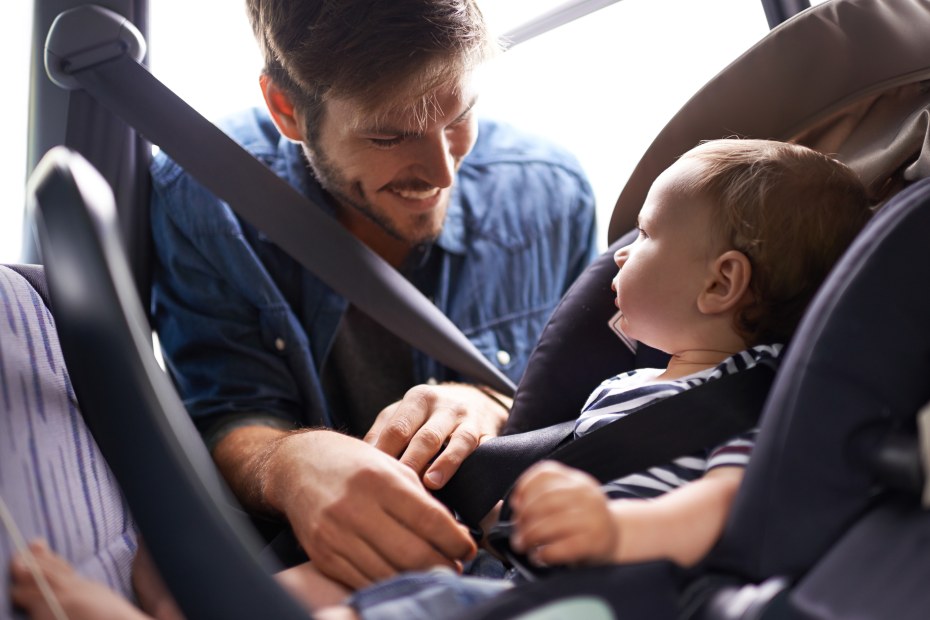When preparing for a new baby or your child’s next stage, one of the most important decisions you’ll make is choosing a car seat worthy of protecting your little one. The glut of reviews, personal recommendations, and articles can be overwhelming. But picking the right seat—and installing it correctly—doesn’t have to be stressful.
This guide will walk you through the basics of child car seat safety and help you choose the best seat for your child, install it properly, and decide when it’s time to move your child into a forward-facing car seat or booster seat. It will also give you simple steps to ensure that your child’s seat is properly installed and as safe as possible.
How to Choose a Car Seat
There are many brands and styles on the market, but there is no one-size-fits-all car seat. "The best car seat is the one that fits your child, fits your vehicle, is in line with your child's development, and is used correctly every time," says Angela Knudson, a community impact program lead for AAA Northern California, Nevada & Utah and a certified child passenger safety technician who works with parents and families to help keep them safe and prepared on the road.
When buying a car seat, you'll need to decide whether you want a rear-facing only (often called an infant car seat) or a convertible car seat that adapts as your child grows. Deciding between the two is a personal choice based on your individual needs and preferences.
A rear-facing only car seat has a handle, and the seat can be easily removed from its sturdy base once the base is installed in your car. This means you can carry your baby into the house or clip them into a stroller without taking them out of the car seat—and interrupting a nap. Rear-facing only car seats typically hold children up to 40 pounds or up to 30 to 32-inches tall (check the manual for the manufacturer’s specific guidelines), and you can install a base in each car so you can quickly snap the seat in place and go. Additional bases are a fraction of the price of another car seat.
A convertible car seat, on the other hand, remains in your car at all times and has a higher height and weight limit. The car seat can be adjusted and repositioned as your child grows from a newborn to a toddler to a big kid. Many hold children that weigh 65 pounds or more. However, you need to properly reinstall the car seat or purchase more than one seat if your child will frequently ride in more than one vehicle.
As you begin to research specific car seats, look to trusted sources such as the Consumer Reports car seat buying guide or the New York Times product review site, Wirecutter, recommendations for infant and convertible or all-in-one seats. Also check car seat recalls on the National Highway Traffic Safety Administration (NHTSA) website before purchasing or reusing a seat from an older sibling.
When to Pick Rear- or Forward-Facing
Although laws vary by state, for maximum safety your child must start rear-facing and should ride this way until the car seat's upper weight and height limits are reached rather than transition from rear-facing to forward-facing when they turn 2 years old. Infants and toddlers should ride rear-facing as long as they can to best protect their head, neck, and spine while the vehicle is in motion. According to the American Academy of Pediatrics, which issued this new recommendation in August 2018, most convertible seats now have weight and height limits that allow children to ride rear-facing for two years or longer before needing to transition to forward-facing.

Experts recommend waiting until your child hits the height or weight limit on their car seat before moving to a booster seat.
Booster Seat Basics
When your child outgrows the height and weight limits (typically around 65 pounds, but check manufacturer’s guidelines) on their forward-facing car seat, they will need to transition to a belt-positioning booster seat. The purpose of a booster seat is to elevate your child so the seat belt fits their shoulder and hips properly. In case of a crash or sudden braking, the adjusted belt position provides better protection.
Like infant-only and convertible car seats, it's wise to keep your child in a booster seat until they have reached the seat’s weight and height limits, even if this is longer than your state requires. There's no need to rush your child into or out of a booster seat. The American Academy of Pediatrics recommends a booster seat until a child is tall enough for the seat belt to properly fit without it. This often occurs when a child is between 8 and 12 years old and is around 4'9" tall.
Car Seat and Booster Seat Laws by State
Although every state has unique child passenger safety laws, the American Academy of Pediatrics recommendations—infants and toddlers should ride rear-facing until they hit the height and weight limits of their rear-facing seat, children should then ride in a forward-facing until they outgrow the maximums of the car seat, and finally children should use a booster seat until they are tall enough for the seat belt to properly fit without it (around 4'9" tall)—are the gold standard.
California Car Seat and Booster Laws
- Children must be properly secured in a rear-facing car seat until they are two years old or older, more than 40 lbs. or taller than 40 inches.
- Children under the age of 8 and under 57 inches must be secured in a child passenger restraint system (including a car seat or booster) in the back seat.
Arizona Car Seat and Booster Laws
- Children under 5 must be secured in a rear- or forward-facing car seat.
- Children ages 5 to 8 must use a booster seat until they are at least 57 inches tall.
Hawaii Car Seat and Booster Laws
- Children under 2 must ride in a rear-facing child safety seat.
- Children 2 to under the age of four must ride in a rear- or forward-facing child safety seat.
- Children ages 4 to less than 10 must ride in a child safety seat or booster seat unless they are over 4’9”.
Idaho Car Seat and Booster Laws
- Children under age 6 are required to be in a car seat or booster.
Montana Car Seat and Booster Laws
- Children under 6 years old who weigh less than 60 lbs. must be properly restrained in a child passenger restraint system.
Nevada Car Seat and Booster Laws
- Children under 2 must ride in a rear-facing child safety seat in the back seat.
- Children younger than 6 who are less than or equal to 57 inches tall must be secured in a child passenger restraint system appropriate for their height and weight.
Oregon Car Seat and Booster Laws
- Infants must ride in a rear-facing car seat until they are 2 years old.
- Children who weigh 40 lbs. or less must be properly secured in an approved child safety seat with a harness.
- Booster seats are required until children are at least 8 years old and the seat belt properly fits their hips and shoulders without a booster seat or until they are at least 4’9”.
Utah Car Seat and Booster Laws
- Children under age 8 and under 4’9” tall are required to use a car seat or booster seat.
Wyoming Car Seat and Booster Laws
- Children under age 8 must be secured in a car seat or booster in the rear seat, unless all of the seat belts in the back seat are in use for other restrained children.

A simple inspection will check your installation and make sure you are properly using the child safety seat.
How to Properly Install and Inspect a Car Seat
Every new car seat comes with installation instructions to guide you through the process, but three out of four car seats are improperly installed according to Knudson.
"When car seats are installed and used correctly, they can reduce the risk of infant fatal injuries by 71 percent," Knudson says. For this reason, AAA offers free car seat inspections to AAA Members and nonmembers at more than 100 locations in the West.
"Know that there are certified technicians available to make sure your kiddo is traveling safely," Knudson says. All child passenger safety technicians, including Knudson, are certified by Safe Kids Worldwide, a leading nonprofit child safety organization.
Beyond ensuring your car seat is installed properly, certified technicians can educate you on how best to use your car seat. For example, in a rear-facing car seat, the top of the harness should fit snugly at or below your infant's shoulders and you should not be able to pinch any extra slack. When forward-facing, the top of the harness straps should be situated at or above your child's shoulders. The chest clip should always be at armpit level.
"Know this is a complex process, installing a car seat," Knudson says. "Let a AAA expert take the worry out of it. As you're expanding your family, make sure their safety is on your checklist."
Key Steps for Child Passenger Safety
Car seat safety can be a lot to process. Guidelines change, car seats are recalled, and new car seat models enter the market all the time. With this in mind, here are four final thoughts:
- Understand that there is no "best" car seat. Look to the Car Seat Guide from AAA and other trusted sources to educate yourself on car seats and keep your kid safe at every stage. This is also an excellent resource to stay up to date with changing safety guidelines and regulations.
- Get checked. AAA child passenger safety technicians are available to inspect your car seat and help you use it properly. They can even answer questions related to moving seats between cars, using taxis or car shares with car seats, and best practices for traveling by plane with a car seat. This free service is available to everyone.
- Stay on top of safety recalls. Register your car and your car seat with their manufacturers, so you are informed directly of any future safety recalls. If you move, let both makers know your new address. Also, be aware that car seats typically expire six years after their date of manufacture. According to Knudson, this is because materials degrade over time when exposed to extreme temperatures in vehicles. Due to ever-evolving government regulations, older car seats can also become unsafe over time.
- Always replace a car seat after a crash unless all of the following are true:
- The vehicle was able to be driven away.
- The vehicle door closest to the car seat was not damaged.
- None of the passengers in the vehicle sustained any injuries in the crash.
- The vehicle has air bags, but they did not deploy during the crash; and
- There is no visible damage to the car seat.
